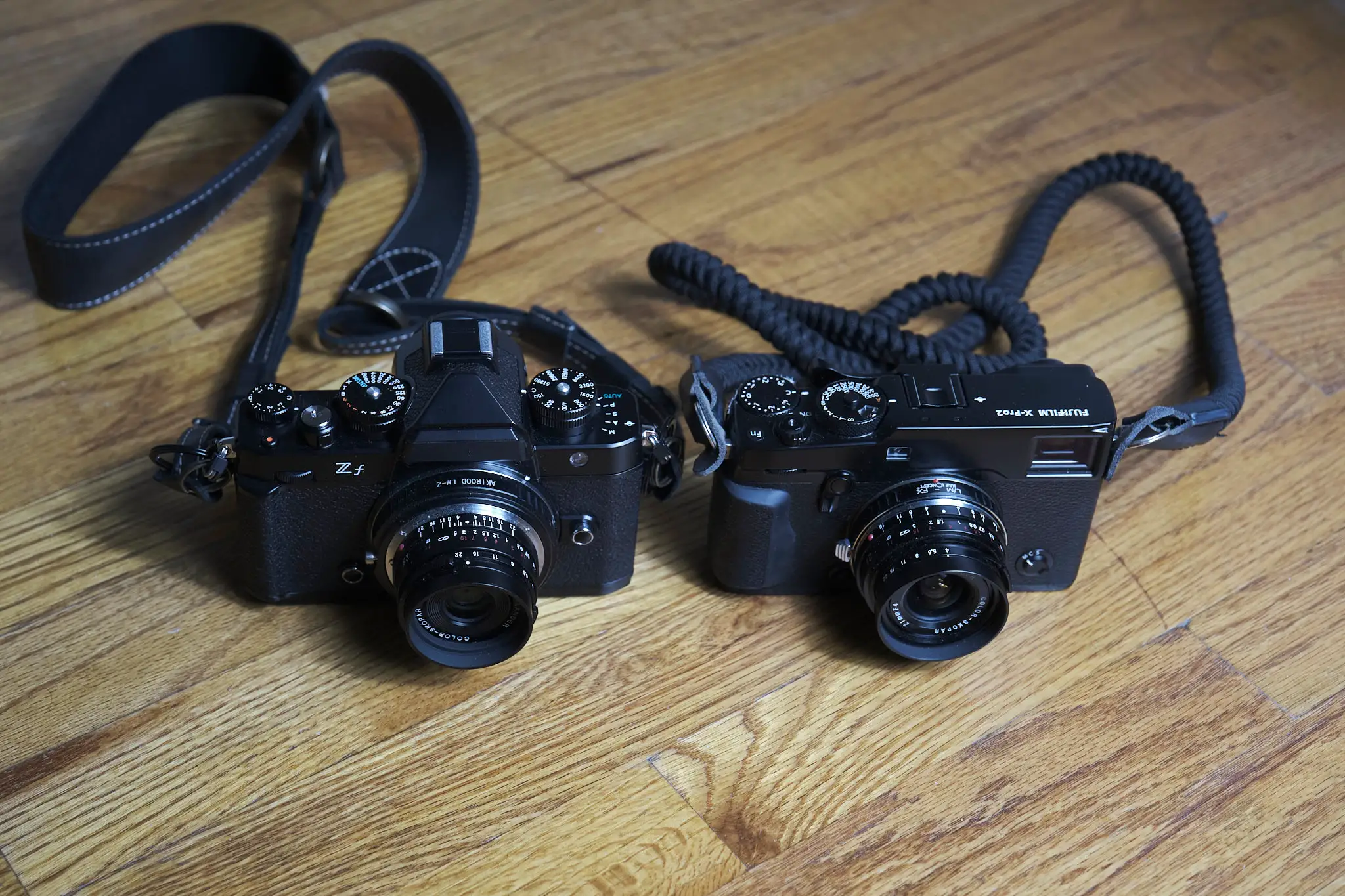TL:DR
Pros
- Retro style design
- Great image quality
- Fast!
- Beautiful colors
- Good in low light
- Robust body
- Plenty of customization via Picture Control
Cons
- Lack of OVF
- The handling can be a problem when paired with long lenses (needs a grip)
- Lack of aperture ring on Nikon’s native lenses
A few days ago, I received the new Nikon ZF.
When I opened the box and held the camera for the first time, my reaction wasn’t exactly what I had imagined.
I didn’t find anything particularly off with the camera. The weight was what I had expected. But the dials felt a little odd at the touch, and the D-pad too.
And then I remembered on some YT video someone talking about a plasticky feel of the dials.
I put that thought aside, and started charging the battery, as what I only wanted to do, of course, was to test the camera.
I’ll come back to the plasticky feeling later.
It’s my first Nikon, and yet the menu, the setup, everything fell into place.
Before I proceed, a few caveats.
- I will compare the ZF to the X-Pro2. It’s not a fair comparison. There’s a seven-year gap between the two cameras. But for me, it matters because the X-Pro2 has been the paradigm. Can the experience get better? If so, in which way?
- This review is from a street photographer’s point of view. Mileage may vary depending on the genre you shoot.
- I’ll do my best with the details, but I’m not a technical person.
- If you’re are Fuji shooter thinking of switching, make sure you check the camera in a store. It’s crucial to get an idea of how a new camera feels while holding it.
Handling: I’m only using the camera strap, I’m not adding a grip. I use CV wide-angle lenses, and the combo is just perfect as is. Since the camera is always hanging from my shoulder, as I did with my X-Pro2 as well, the strap is all that’s needed for this camera. Its grip is good enough when using small lenses. The complaints you hear about the grip make sense when the camera is coupled with a long lens. But this camera is not a Z8 or Z9. It’s aimed at everyday situations, like street photographers.
Dials, and buttons layout: it’s all easily reachable. The distance and position of the buttons make sense and become natural rather quickly. Reaching for the “i” button is a better experience than dealing with the “q” button on the X-Pro 2.
The exposure compensation dial is where an X-Pro 2 user would expect to find it. The similarities don’t end here: if you move the dial to C, you can then control the exposure compensation by the main command dial located on the rear of the camera (on the X-Pro 2, one would use the front command dial).
Colours: gorgeous. I find the colours from the Nikon to look very natural. The warm is never overdone; the skin doesn’t look artificial or too perfect for lack of a better term — I’m thinking of Canon and the way, to me, its skin colours look lacquered. The monochrome is astounding.
Metering: On several occasions, I struggled to get a good measurement with the X-Pro2. Especially here in LA, with the harsh light conditions, it’s indeed been challenging. After a first run, the ZF didn’t disappoint. I pointed the camera directly toward the brightest area, with the sun peeking right behind some trees while shooting some figures in the foreground. The exposure was pleasant, with details in the darker parts of the image. With the X-Pro2, I would have expected either the half-bottom to be dark or the half-top. There’s also the highlight weighted-metering which I haven’t tested yet.
EVF: big, bright, sharp.
LCD: Nikon did the right thing by adding a fully articulated LCD to the ZF. I keep it closed, which adds the perfect touch to the manual street shooter experience. I didn’t use the LCD on my X-Pro2, but I like the ZF occluded LCD even better. Less risk of accidental scratches. I will test it more thoroughly when I’ll shoot some video.
Overall Speed: this camera is fast. Gone are the days when I could miss the shot because the X-Pro2 was on power save mode, or I was turning it on, and it needed time to be responsive. The ZF is snappy.
Low-light: maybe this is not news for full-frame shooters, but to me, the fact that I can push the ISO this much is a step up. At 12,800 ISO the images look just fine and are usable. I will do further testing in this regard.
Lenses: to my knowledge, there are only two lenses on the market that match the ZF retro style at the moment. The 40mm f/2 SE, and the 28mm f/2.8 SE. This can be a limit for someone. Furthermore, it seems the two lenses available aren’t on par with the build construction of the ZF. But considering the extensive production of lenses when it comes to Nikon, I would expect more in the line of the two aforementioned SE lenses soon or later next year. For me, this is not an issue as I shoot manually all the time with Voigtländer lenses.
As for the argument that Fuji lenses are more retro than Nikon’s, most Fuji lenses use focus by wire. They indeed have the aperture ring, but other than that, when it comes to focusing, you still need to rely on the auto-focus capacity of the camera. This has been quite a cons for me. I didn’t take this aspect into account when I bought the 23mm and the 35mm WR f/2. When I realized AF wasn’t the way to go on the X-Pro 2, I put those lenses into a camera bag and they rarely saw the light again.
Picture Control: and I thought film simulation was only part of the Fujifilm realm. Picture control on Nikon is equally great. I actually think that potentially it has more use. Here’s why. On Fuji, film simulations are tied to a line of cameras (due to the processor). Also, creating them on your computer, although possible, is a little more cumbersome. To copy the simulation to your camera, you have to connect the camera to the computer. And with an older Fuji camera, this is not possible. You have to set the simulation manually on the camera. On Nikon you can save the picture control to an SD card, then copy it directly from the camera. Theoretically, one could skip using the software altogether, and just use this Nikon Picture Control Editor
On a side note: I read that on Fujifilm cameras, Clarity affects the performance. I couldn’t check this as on the X-Pro 2, Clarity isn’t available. On the ZF, not only do you have a Clarity option while retaining the same performance, but the fan part is that you can also pick one of the presets, and tone down the opacity. It’s like having an adjustment layer in Photoshop, and deciding how much the adjustment will affect the layer underneath.
Auto-focus: since I’m using manual lenses, I couldn’t test it. From what I’ve seen on the videos around, it seems to be fast and accurate. The funny thing is, I started using manual lenses because on the X-Pro 2, the auto-focus was sometimes a gamble, and not exactly fast.
Smartphone App: the Nikon app just works. (needs more testing)
Video: The video specs are great. The ZF can record 10-bit internally 4:2:2 in N-log. It comes with an 8-stop IBIS.
Monochrome switch: I thought this was going to be a gimmick. I couldn’t have been more wrong. What a neat choice Nikon made here! I find myself switching to monochrome more and more, and the dial makes it a breeze.
How does the ZF differ from other Fuji cameras? So, one could argue why not simply go with a newer Fuji camera if we’re ready to give up on the OVF experience. At the moment, the only “new” camera that still retains some retro style look and setup, is the Fuji X-T5, at least in the higher end of the line.
Nikon Zf Samples
The following images have been edited with NX Studio.
I was surprised by the quality of this software. The interface looks dated, but the controls are there, and there’s a lot to play with to get the desired result.











Nikon ZF Low Light sample
The streets in LA are barely lit. When walking down a street, it’s not uncommon to see people using their phones’ flashlights to better see where they’re going.
Here’s an example below on the left. This is straight out of the camera at ISO 64000:
As you can notice, with the camera default settings, the image tends to be overly bright. That’s not how the street looked.
So, I took the RAW in NX Studio, and to my surprise, there was plenty of information to recover. Hint: Nikon’s D-Lighting can be useful.
Edited version on the right:


And here’s a 100% crop:

Nx Studio Interface.

It’s worth noting that when the default settings are tweaked, it’s possible to save the settings as a new Picture Control.
At that point, the new Picture Control can be exported and copied to an SD card. When the SD card is inserted into the camera, it can be stored internally to be used as a new Picture Control.
The steps are easy:
- On the SD card, create a folder called
NIKON(all caps) - Inside the folder just created, create another folder called
CUSTOMPC(with no spaces) - Finally, copy the presets exported from NX Studio (or from Picture Control Utility) to the
CUSTOMPCfolder on the SD Card - From the menu of your camera, you can now choose to save the custom preset locally to your camera
Alternatives
To be honest, the X-T5 build quality is a little disappointing. Not only the body is prone to scratches, but also when I tested the camera it felt oddly light.
The ZF has a retro-style design, but it also feels sturdy. Going back to the comparison with the X-Pro 2, the striking difference will always be the presence of the EVF instead of an OVF. That’s what the final buyer will have to deal with and decide whether the EVF will be enough.
And finally, let’s go back to the plasticky feeling of the dials. They did feel somehow different from the X-Pro2 , but there’s also quite some friction to them. Then, while using the camera in the field, I realized the feeling and the friction were just fine. I found the friction to be right. Less chance of turning the dial too much to the right or left. So, what’s the deal with the dials?
On my X-Pro2 I ended up adding gaffer tape to the exposure compensation dial and the diopter. They always turned one way or another, messing up my settings. And yet, even the tape hasn’t proved to be a definitive solution. They still move, sometimes when I take the camera out of my bag or while handling it. This is nothing new. X-Pro2 users are aware of this problem.
The ZF is built to feel more like a rugged camera. The dials stay in place. Not only the plasticky feel doesn’t bother me, but it also gives me peace of mind, as I know the knobs won’t go off unexpectedly.
What do I miss about my X-Pro2?
In one word, OVF.
So, how big of a deal is the EVF?
Time will tell. I’ve been shooting with the X-Pro 2 for six years, always using the OVF. Of course, it’s a different experience than using the EVF. Also, the setup of the X-Pro 2 with the OVF on the left side it’s something I like a lot.
I never thought I’d use a camera with an EVF, let alone positioned in the center. But so far it’s working just fine.
One thing occurred to me though. As I mentioned before, one issue with the X-Pro 2 is the power management. The camera would go into a suspended mode if not used for some minutes. The problem is that getting the camera back to operational is not as instantaneous as one would think, which could be an issue if I decide to take the shot but the camera is not ready.
With the OVF, this issue is potentially emphasized as there’s no clear indication whether the camera is ready or not. When using an EVF, if what you see is pitch black, it means the camera needs to be woken up, and in the case of the ZF, it only takes a flick.
One more note about the OVF (and I know already Fuji aficionados will hate me for this).
I can’t stress enough how much I love the OVF experience. But let’s be honest, the rangefinder experience on the X-Pro line despite being the closest thing to a Leica we have on the market, it’s not the same thing.
Fujifilm did something smart when implemented the ERF, but in reality, I’ve never been comfortable using it. Unless you’re shooting something else than street photography, it’s just distracting, plain and simple. You can either look at the OVF, or the ERF. The moment you want to make sure you have the subject in focus by peeking at the ERF, you miss the shot. This is not how Leica cameras work.
That’s only part of the problem. Leica is notorious for its minimalism, something no other camera on the market can compete with.
At the end of the day, the X-Pro line, with all its glorious pros, is not the Leica experience we wish it were. It’s something else. Great? Sure, but not a Leica though.
So, there. I love it, but it’s always been a compromise. And at this point, it comes down to what compromise I can live with. The EVF on the ZF seems to be good enough of a compromise as well.
A word on the Nikon experience, and final consideration.
I’m new to Nikon. I don’t know how they handle their customers in terms of requests, support, and communication.
My first taste of Nikon customer support was my very recent experience with dust on the sensor of the ZF.
Of course, despite being always extremely cautious, the moment I mounted my Voigtländer one speck of dust found its way to the sensor (when I think of those Youtubers mounting lenses outdoors in plain daylight, with the camera facing up!)
I never thought I’d need to check the manual to clean a mirrorless camera sensor. I did what I always do. With my sensor cleaning kit at hand, and the camera switched off, I performed the cleaning. The dust was gone, and the camera was back in business.
Then, on second thoughts, I asked on a forum if by chance the ZF needs a specific procedure when cleaning the sensor. The can of worms opened, and I wasn’t ready for it.
“The IBIS doesn’t lock off when the camera shuts down”, “there’s to dust protector shield”, and “the camera needs to be ON when cleaning the sensor”.
But the one that made me nervous was: “In the manual, they explicitly state that the only way to clean the sensor is with the automatic cleaning the camera performs, and under no circumstances the end-user should touch or wipe the sensor”.
Well, it turns out the automatic cleaning on my model was off by default (go figure).
It’s worth noting that on other Nikon cameras with a similar system, the IBIS automatically locks off when the camera is switched off.
So, I reached out to Nikon technical support. This phone call was very different from the one I had with Fuji technical support. The latter was a pleasant experience, with a technician being very detailed and knowledgeable about the information he was providing. The former felt like I was talking to Bed Bath and Beyond customer support. They couldn’t advise much, and so they wished me a good day.
I then decided to try again, this time via email, hoping that a different department would be involved, and possibly, be in better hands.
Me:
“[…] do I need to send the camera to a Nikon support centre for repair every time there’s some dust on the sensor, and the automatic cleaning doesn’t work?”
Nikon:
“Unfortunately, Yes. We can’t advise on any other way, but if what you’ve done is working, proceed with caution.”
Me:
“Thanks for confirming. And just to be clear, does the camera need to be on while cleaning the sensor with a cleaning kit?”
Nikon:
“We can not advise on that.”
I find it quite impractical to have to send the camera in for a cleaning.
I understand they want to be cautious about preventing any damage to the camera, but I think in the mirrorless realm, we’re all quite used to doing it, and this approach by Nikon seems a little too stretched.
Furthermore, not telling the customers how to properly perform the sensor cleaning is nothing less than a conundrum. If anything, it can only lead to more damage than expected. It would suffice to know how the ZF sensor cleaning procedure differs from other cameras so that we don’t have to guess.
This dilemma seems to be caused by the presence of the IBIS. Apparently, on the ZF, the IBIS doesn’t lock off when the camera is switched off. Therefore, due to the moveable part, cleaning the sensor on the ZF seems to be a different deal than with other mirrorless cameras. I would have gladly given up on the IBIS altogether if would had meant avoiding this confusion. After all, I’m not planning on shooting video, and without IBIS the camera would cost less, and possibly, be sturdier.
All cameras have pros and cons. As described above, the experience with Nikon support left me with a little bit of a bitter taste.
At some point, I might need their technical support. And perhaps, from a technical standpoint, they might be excellent. But their way of forcing the customer into a Hobson’s choice is something I don’t quite understand, and sows doubt about other policies I might not be aware of yet.
Update: I’ve been in touch with Nikon technical support via email multiple times over the past two months. Their response has always been relatively quick, courteous, and eloquent enough.



Leave a Reply